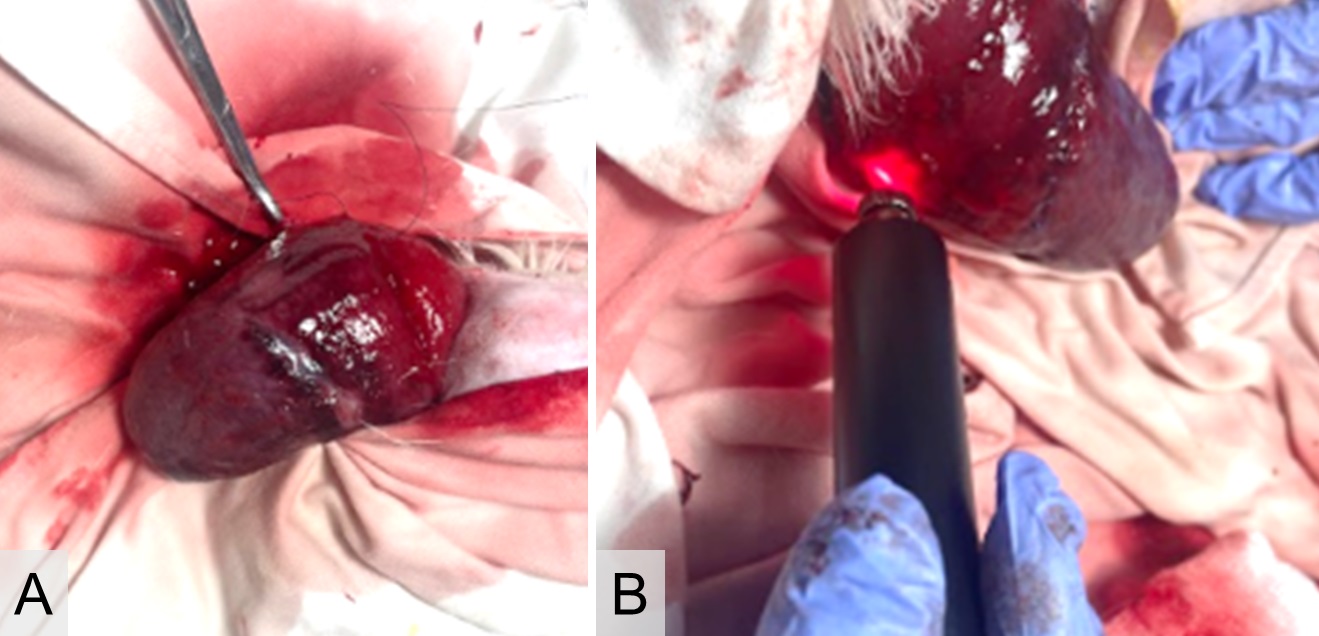Combined therapy of laser puncture and surgical repositioning of rectal prolapse accompanied by rupture in goats
Abstract
Rectal prolapse occurs when the rectum protrudes from the anus. This article reports a case of a male goat named Jimmy, presented to the Cimanggu Animal Clinic with a mass protruding from his anus. Physical examination revealed diarrhea, and the mass was a rectal prolapse with three ruptures in the rectal wall accompanied by swelling and bleeding. Jimmy was diagnosed with rectal prolapse with ruptures. Treatment involved suturing the ruptures and performing laser puncture at the suture sites and prolapsed rectum at the Lian Hua point, followed by repositioning. Additional laser puncture was performed after repositioning at the GV-1, GV-20, ST-36, and Gang Tuo acupuncture points using 0.5 Joules of energy and 50 mW of power. Metronidazole was administered intravenously at 75 mg/kg body weight for 3 days to manage the diarrhea. Improvement was noted on the third day post-surgery, with the goat's feces forming pellets and the anal sphincter condition improved. One month after surgery, the goat was discharged with pellet-shaped feces, good appetite, strong anal and sphincter condition, and no recurrence of prolapse. This case highlights the successful management of rectal prolapse in goats by using a combination of surgical intervention, laser puncture, and antibiotic therapy.
Downloads
References
Adikara RTS. 2019. Laserpunktur Hewan. Surabaya: Airlangga University Press hlm 45.
Allen DG, Smith DA, Pringle JK. 1998. Handbooks of Veterinary Drugs. US: J. B. Lippincott Company. 886 pp.
Arulkumar S, Arunkumar R, Ragulraj S, Priyadharsini R. 2022. Correction and management of rectal prolapse in indigenous goat: A case report. The Pharma Innovation Journal. SP-11 (8):698-699. https://doi.org/10.22271/tpi.2022.v11.i5i.12469
Chakrabarti A. 2018. Text Book of Clinical Veterinary Medicine. 4th ed. India, New Delhi: Kalyani Publishers,
Dharmojono. 2013. Basics of Acupuncture and Veterinary Moxibustion- Small Animals. Jakarta (ID): Trubus Agriwidya. 151 pp.
Hartnack A, Jones M. 2017. Surgery of the sheep and goat digestive system. Farm Animal Surgery. 2nd ed US: Elsevier Publishing. 561-567. https://doi.org/10.1016/B978-0-323-31665-1.00021-6
Stux G, Hammerschlag R. 2001. Clinical Acupuncture, Scientific Basis. Berlin (DE): Springer. p 1-28. https://doi.org/10.1007/978-3-642-56732-2
Venkatachalam D, Chambers P, Kongara K, Singh P. 2018. Toxicity and pharmacokinetic studies of lidocaine and its active metabolite, monoethylglycinexylidide, in goat kids. Animals (Basels). 8(8):142.
https://doi.org/10.3390/ani8080142 | PMid:30127249 | PMCid:PMC6115778
Xie H, Preast V. 2007. Xie's Veterinary Acupuncture. US: Blackwell Publishing. 320. https://doi.org/10.1002/9780470344569

Copyright (c) 2024 CC-BY-SA

This work is licensed under a Creative Commons Attribution-ShareAlike 4.0 International License.
Authors who publish with this journal agree to the following terms:
1. Authors retain copyright and grant the journal right of first publication with the work simultaneously licensed under a Creative Commons Attribution License that allows others to share the work with an acknowledgement of the work's authorship and initial publication in this journal.
2. Authors are able to enter into separate, additional contractual arrangements for the non-exclusive distribution of the journal's published version of the work (e.g., post it to an institutional repository or publish it in a book), with an acknowledgement of its initial publication in this journal.
3. Authors are permitted and encouraged to post their work online (e.g., in institutional repositories or on their website) prior to and during the submission process, as it can lead to productive exchanges, as well as earlier and greater citation of published work (See The Effect of Open Access).

.jpg)















